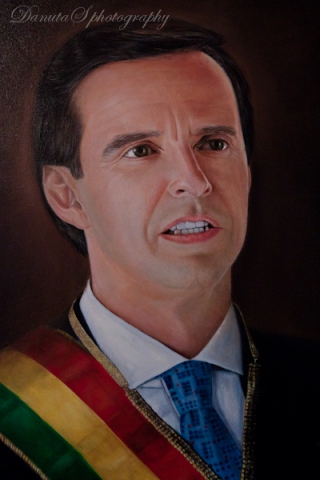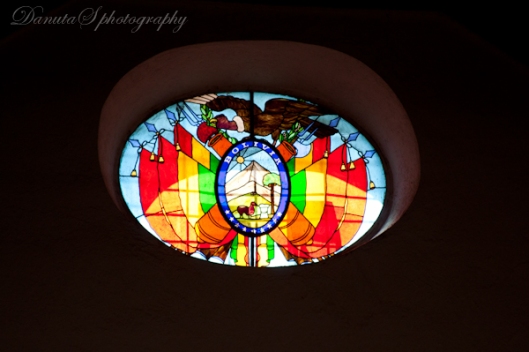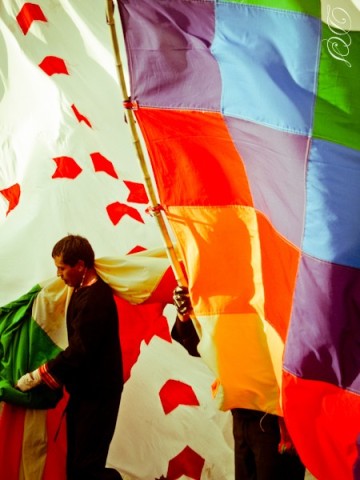Boliwia, świętuje Dzień Niepodległości (Dia de la Patria) w dniu 6 sierpnia. We wszystkich miastach organizowane sa patriotyczne marsze, parady wojskowe, tańce uliczne i imprezy kulturalne, ktore odzwierciedlają bogate dziedzictwo kraju.
Bolivia, celebrates its Independence Day on August 6. The Independence Day, also known as Dia de la Patria, is a national holiday in Bolivia and celebrations are held throughout the country with patriotic marches, military parades, school bands marches, gun salutes, street dances and carnivals, and cultural events reflecting the rich heritage of the country.
Trochę historii w skrocie/ A bit of history:
Hiszpańska okupacja Boliwii, wcześniej znanej jako Górne Peru lub Charcas, rozpoczęła się w 1525. W tym okresie wielkie zasoby srebra Boliwii staly sie filarem hiszpańskiego bogactwa. Wpływ kolonizatorow zaczal sie zmniejszac w czasie wojen napoleońskich, kiedy nastroje nacjonalistyczne zaczęły rosnac ze względu na szereg wydarzeń w hiszpańskiej Ameryce, ale przede wszystkim dzieki wysiłkom Simona Bolivara – wenezuelskiego przywódcy politycznego i wojskowego, który prowadził walki przeciwko hiszpańskiej władzy kolonialnej w regionie. Simon Bolivar oraz jego towarzysze – Jose de San Martin i Antonio Jose de Sucre – byli przywodcami wielu kampanii powstanczych na terenie Boliwii.
The Spanish occupation of Bolivia, previously known as Upper Peru or Charcas, began in 1525, and at the time Bolivia was governed by the viceroy of Lima. During this period Bolivian silver became the mainstay of Spanish wealth. Spanish influence, however, began to decline during the Napoleonic wars, and the nationalist sentiments began growing due to a number of events in Spanish America, but mainly because of the efforts of Simon Bolivar, a Venezuelan military and political leader who led numerous wars against Spanish colonial rule in the region. Simon Bolivar’s companions – Jose de San Martin and Antonio Jose de Sucre – also led many such independence campaigns.
W teorii, Boliwia ogłosiła wolność w 1809 roku, ale musialo minac koleknych 16 lat, zanim stała się republiką. Wreszcie, w dniu 6 sierpnia 1825 roku wysiłki Simona Bolivara zostały nagrodzone ustanowieniem Republiki Boliwii. Jak latwo sie domyslic, kraj zaczął być nazywany Boliwia na czesc legendarnego bohatera.
Niestety, okres wojny doprowadzil do niestabilności zarowno politycznej jak i gospodarczej Boliwii, i tak, od czasu uzyskania niepodległości, straciła ona ponad połowę swojego terytorium na rzecz krajów sąsiednich.
In theory, Bolivia proclaimed its freedom in 1809, but it took another 16 years of war before Bolivia became a republic. Finally, on August 6, 1825, the efforts of Simon Bolivar were rewarded with the establishment of the Republic of Bolivia, that was called after its legendary hero.
However, a period of political and economic instability in the early-to-mid-19th century weakened Bolivia. Thus, since independence, Bolivia has lost over half of its territory to neighboring countries.
Symbole narodowe Boliwii/ National symbols:
Flaga Boliwii została przyjęta w dniu 31 października 1851 roku. Składa się ona z trzech poziomych pasów o równej wielkości: czerwonego, zoltego i zielonego. Kolor zielony symbolizuje bujny urodzajność ziemi, żółty uosabia zasoby naturalne kraju, a czerwony oznacza odwagę boliwijskich żołnierzy, walczacych o niepodleglosc.
The national flag of Bolivia was adopted on October 31, 1851. It consists of three horizontal stripes of equal size. The top band is red, the middle is yellow, and the bottom band is green. The green color symbolizes the lush fertility of the land, yellow epitomizes the natural resources of the country, and red represents the courage of the Bolivian soldiers who fought for the independence and for the preservation of the country.
(Boliwijski Alan Partridge)
Herb Boliwii sklada sie z centralnego kartusza otoczonego flagami Boliwii, muszkietami, które symbolizują walkę o niepodległość, siekiera i czerwonym kapturem frygijskim, który jest symbolem wolności i swobody oraz gałęziami laurowymi, symbolem pokoju. Kondor, siedzący na tarczy jest zas symbolem chęci obrony narodu i jego wolności. Centralny kartusz otoczony jest dziesiecioma gwiazdami, które symbolizują dziewięć obecnych departamentos i utracona prowincje Litoral, przejeta przez Chile w 1879 roku. W górnej sekcji znajduje sie nazwa ‘Boliwia’. W kartuszy widoczne sa: góra Potosi ‘Cerro Rico i wschodzące nad nia słońce. Ponizej alpaca symbolizujaca Altiplano, palmy – symbol zachodniej tropikalnej części Boliwii oraz snop przenicy, symbolizujacy zyzne doliny Cochabamba i Tarija.
The coat of arms of Bolivia has a central cartouche surrounded by Bolivian flags, muskets that symbolizes the struggle for independence, an axe and a red Phrygian hood, which is the symbol of liberty and freedom and the laurel branches symbols of peace. The condor, perched upon the shield, represents willingness to defend the nation and its liberty. The central cartouche has a border with ten stars in the bottom, which symbolize the nine Departments and the former province Litoral that was taken over by Chile in 1879, and the name of Bolivia in the top section. Within the border the silver mountain Potosí ‘Cerro Rico’ is depicted, with a sun rising above it. Alpaca symbolises Altiplano, a palm tree – Western tropical parts of Bolivia and some wheat – valleys of Cochabamba and Tarija.
Whipala – wielokolorowa flaga,obecnie kojarzona z rzadzaca partia polityczna Evo Moralesa, uznana zostala dosyc niedawno za nowe godlo, które powinno być powieszone po lewej stronie flagi Boliwii. Whipala powinna reprezentowac wielokulturowosc Estado Pluronacjonal, ale w rzeczywistosci jest symbolem ludow Aymara i Quechua zamieszkojacych Altiplano. Dlatego tez w niektórych departamentach, jak Santa Cruz, flaga ta jest nieobecna. Zreszta Crucenos, niezgadzajacy sie z polityka Evo Moralesa czy raczej z jego przynaleznoscia etniczna, 6 sierpnia świętuja swoja zielono-biało-zieloną flagę i własny hymn.
Whipala – a multicoloured flag invented in 1973 (now symbol of Evo Morales’ political party) is a new national emblem, that usually should be flown to the left of Bolivian flag. It represents Aymara and Quechua people of Western Bolivia and because of that in some departments like Santa Cruz, this flag is absent. Crucenos, as opposed to Evo Morales’ politics as well as his ethnic origin, on 6th August celebrate their own green-white-green flag and their own anthem.
Teczowe kolory flagi Whipala, skladajacej sie z 49 kwadratow, symbolizuja/The whipala contains 49 squares using the seven visible colors of the rainbow which represent the following:
* Czerwony: Ziemie i czlowieka andyjskiego/ Red: The Earth and the Andean man
* Pomaranczowy: Społeczeństwo i kulture/ Orange: Society and culture
* Żółty: Energie/ Yellow: Energy
* Biały: Czas/ White: Time
* Zielony: Zasoby naturalne/ Green: Natural resources
* Niebieski: Niebiosa/ Blue: The heavens
* Fioletowy: rząd andyjski i samostanowienie/ Violet: Andean government and self-determination
Jako ze Imperium Inków zostało podzielone na cztery główne regiony (zwane suyus) istnieja cztery Whipalas Boliwii, w ktorych ukośne paski i kolorowe kwadraty ułożone sa inaczej, w zależności od suyu, lub regionu, ktory flaga ma symbolizować.
As, the Incan Empire was divided into four main regions (called suyus), there are actually four whipalas in Bolivia, where the diagonal stripes of colored squares are arranged differently, depending on which suyu, or region, the flag is meant to represent.
I wreszcie, narodowe kwiaty Boliwii: el pataju i la kantuta. Pierwszy rosnie w tropikach, a ostatni na terenach gorzystych. Oba kwitna w kolorach boliwjskiej flagi. jest jeszcze jedna roslina, utozsamiana na calym swiecie z Boliwia – koka, ktora ma swoj specjalny dzien kiedy indziej:)
And last but not least, the Bolivian national flowers: el patujú & la kantuta. The first grows in the tropics and the latter in the highlands. Both flourish in the colours of Bolivian flag. There is another plant that people around the world associate with Bolivia – coca, which has its own day other time:)

fot. Boliviana de Aviacion facebook page
Sources:
http://www.mapsofworld.com/bolivia/independence-day.html, http://www.boliviabella.com/independence-day.html oraz https://en.wikipedia.org/wiki/Bolivia



